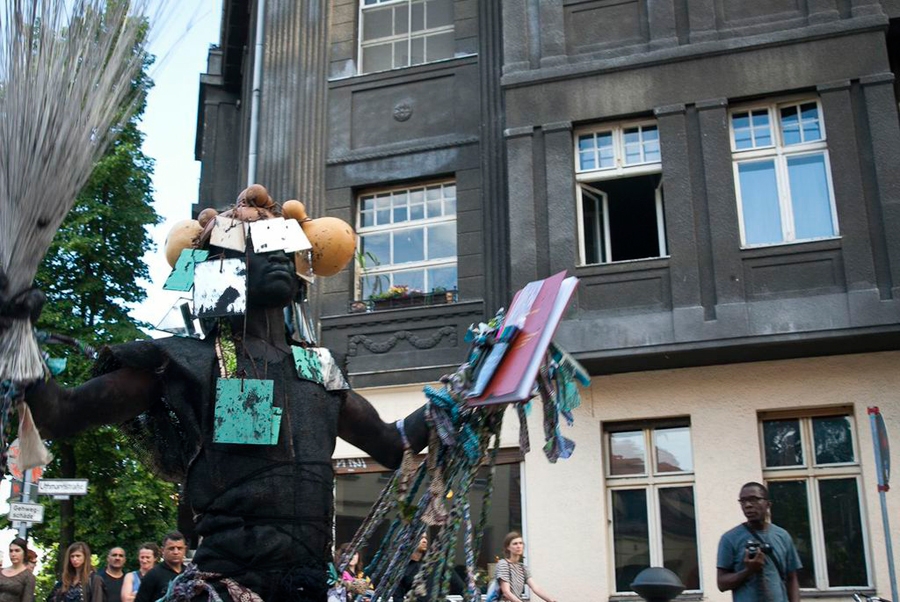In Berlin, project spaces come and go faster than postgrad American expats. Yet every once in a while, a space seems to have some staying power, and a decidedly different mission than the ‘hey-let’s-get-a-bunch-of-twenty-something-friends- together-and-put-experimental-art-on-the- peeling-walls-to-rock / techno / electroclash-music’ thing so common in this city over the past 25 years.
Savvy Contemporary is one of those special spaces. Founded a full five years ago, this ‘laboratory of form-ideas’ (Savvy’s self-appointed subtitle) takes a unique position: in a city whose art production so often grapples with an Eastern / Western Europe narrative, Savvy’s exhibitions and ambitions go global. Each show represents a ‘trialogue’ between the curators, a North American or European artist, and another artist from Africa, South America, Asia or Australia.
In a city whose art production so often grapples with an Eastern / Western Europe narrative, Savvy’s exhibitions and ambitions go global
Past exhibitions, usually bimonthly, were often this simple and straightforward – in 2013, GhostBusters II (Haunted by Heroes) showed artists Kara Lynch and Délio Jasse presented by curators Nadine Siegert and Storm Janse Von Rensburg. More recent projects, however, have expanded the triad into a United Nations-like conversation. For most of 2014, for example, the exhibition and research project Giving Contours to Shadows (partially in cooperation with the Neuer Berliner Kunstverein) mounted an impressively international group exhibition as well as a series of talks and symposia on how the Western canon has dominated historical discussions. The show took Africa as a point of departure, juxtaposing artists like Nigeria-born Otobong Nkanga with Western positions such as that of French-born Alexandre Singh. A series of satellite projects has even been running in African venues, such as the Nairobi Arts Trust / Centre for Contemporary Art of East Africa and the Nest, both in Nairobi, all year.
Savvy’s global approach makes perfect sense considering its founder’s origins: Bonaventure Ndikung (who contributed an article to the October issue of ArtReview) comes from Cameroon. A sharp dresser (snazzy suits, hats and splashy accessories set him far apart from the usual Berlin hipster) as well as a sharp thinker, Ndikung works as a biochemist by day, but oversees an increasingly multipronged endeavour at the Savvy mothership – assisted by coartistic director Elena Agudio and a troupe of young, friendly volunteers hailing from countries as broadly strewn as the Dominican Republic and Russia. In summer 2013, the organisation moved from a small storefront on Richardstrasse in Neukölln’s homey Rixdorf neighbourhood into a two-storey, 400sqm monolithic red-brick power station up the street – apparently the result of Ndikung’s tenacity and negotiation skills (the space hadn’t been used in decades, and part of it may still become luxury lofts, but hopefully not too soon).
About the same time, Savvy won a €30,000 grant from the Berlin Culture Ministry – additional funding comes from donations, a friends’ association, project-specific grants and occasionally renting out the venue. The move has allowed both physical and conceptual expansion: Giving Contours to Shadows, in part funded by the German Federal Cultural Foundation, would have been much more difficult in the smaller old space; an ambitious performance-art programme (curated by Goldsmiths alumna Chiara Cartuccia) now has more room to breathe and evolve. Savvy might still have to close for a week or two in winter when the interior spaces are simply too cold for comfort, but its lightflooded main exhibition space and reading room / library / project archive – which doubles as a stage for discussions on topics like postcolonialism, book readings and film screenings – still attract viewers and researchers. The former storefront space has morphed into a coworking space called Savvy Desk; there’s even a residency for artists and scholars.
It’s humbling to consider how much goes on in this ‘laboratory’ – whose nonprofit status perhaps gives it a certain advantage in mounting projects and shows that official, more institutional (read: bureaucratic) channels for non-Western art in Berlin don’t always have the agility to address. What’s more astonishing is just how much heart Savvy has. Stop by on a weekend and you’ll catch groups of volunteers working and chatting; at openings, bands or DJs perform in the basement and the crowds spill into the back courtyard. In an increasingly transient city that often seems to have become a caricature of its own coolness, Savvy stays smart, independent, postcool. Let’s hope for at least another five years.
This article was first published in the November 2014 issue.
